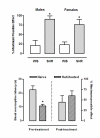Increased sensitivity to cocaine-induced analgesia in Spontaneously Hypertensive Rats (SHR)
- PMID: 17298672
- PMCID: PMC1802084
- DOI: 10.1186/1744-9081-3-9
Increased sensitivity to cocaine-induced analgesia in Spontaneously Hypertensive Rats (SHR)
Abstract
This study examined the analgesic effect of cocaine in Spontaneously Hypertensive Rats (SHR), which are considered a suitable model for the study of attention deficit hyperactivity disorder (ADHD), and in Wistar (WIS) rats of both sexes using the hot-plate test. In addition, we tested whether habituation to the unheated hot-plate apparatus, that "normalizes" the basal hypoalgesic phenotype of SHR, alters the subsequent cocaine-induced analgesia (CIA) in this strain. SHR of both sexes were hypoalgesic compared to WIS rats in the hot-plate test and showed higher sensitivity to CIA. Habituation to the unheated hot-plate reduced the basal nociceptive latency of SHR, suggesting cognitive/emotional modulation of pain in this strain, but did not alter the magnitude of CIA. The present study shows increased sensitivity to CIA in SHR, which may be related to abnormalities in the mesocorticolimbic dopaminergic system. Further studies using SHR strain may reveal new information on the neurobiological mechanisms underlying ADHD and its co-morbidity with drug addiction.
Figures

References
LinkOut - more resources
Full Text Sources

